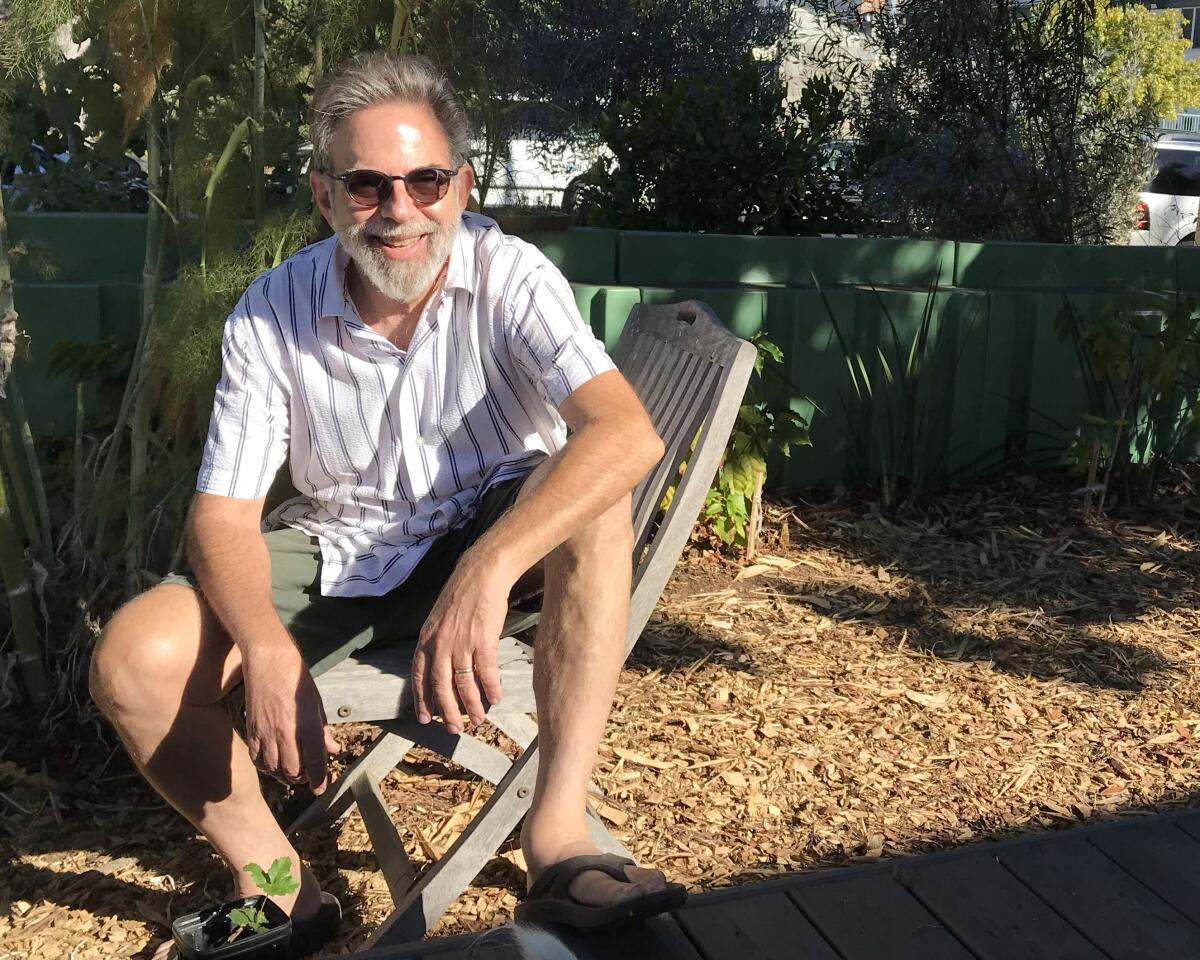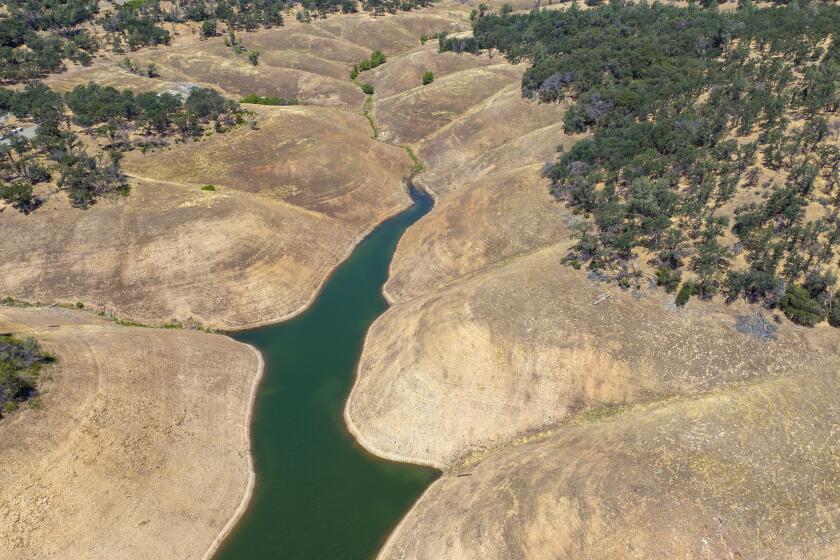Column: Water, water everywhere, and L.A. just lets it go to waste. What we need to do to keep it

The drought is back. The headlines are grim. The governor has just unveiled a plan to cope with an estimated 10% decrease in water supply by 2040 due to the effects of global warming.
In Los Angeles, residential water users are perplexed — they’ve cut back so drastically on their usage that some have a hard time imagining where else they can conserve.
It’s not too often that the answer to such a vexatious question literally falls out of the sky, but if you ask environmentalist Andy Lipkis, you need only look up.
The answer to our water shortage is rainwater.
But we haven’t had any rain, you say?
That may be true for the last little while.
But since Oct. 1, according to the Department of Public Works’ rain gauge, my part of town near Ballona Creek has received 11.5 inches of rain. Downtown L.A. has received 13.5 inches.
When it rains half an inch in Los Angeles, billions of gallons of water fall on the city, and most of it runs to the ocean. That is a huge waste of our most precious resource, and we need to find more and better ways to keep it. Lots of agencies and nonprofit groups are working on that, but there doesn’t seem to be enough coordination, and the world of water politics is riven by rivalries, profit motives and conflicting visions for the future.
In the meantime, the rainwater keeps rushing to the sea.
To get a handle on the problem, I called Lipkis, who founded the education and advocacy group TreePeople 50 years ago when he was a teenager. Talking to him about this topic is a little like standing in front of an open fire hose. You will be drenched by his passion and encyclopedic knowledge, and pretty inspired about what the future can hold if we get our water act together.
On Wednesday, we met at the TreePeople headquarters at the top of Coldwater Canyon. The site has sweeping views of the San Fernando Valley and the San Gabriel Mountains. He shared his story — how he went from a 15-year-old budding environmental activist to stewarding a group that has planted millions of trees and inspired millions of city dwellers to become involved in greening their environments. (Personally, I believe Los Angeles has three people who deserve monuments, if not sainthood: Father Greg Boyle of Homeboy Industries, Gail Abarbanel of the Rape Treatment Center and Lipkis.)
Lipkis is featured in the charming new documentary “Reflection: A Walk With Water” by filmmaker Emmett Brennan. (It will be available to stream Monday on Gaia and to rent or buy on Vimeo on Demand.)
Not enough water, L.A.? Look up.
“The conditions that make life possible are changing very quickly,” says Brennan, who narrates the film. “All the species going extinct, the ecosystems collapsing, the resource wars and extreme weather events.… Four years ago, I went searching for stories of hope and healing, and everything I found had everything to do with water.”
The film takes a spiritual approach as Brennan walks along the 200-mile length of the Los Angeles Aqueduct (most of which is underground) with the nonprofit group Walking Water, which is devoted to creating a better understanding and appreciation of our distorted relationship with water.
The film, naturally, touches on the grotesque destruction of Owens Lake by the city of Los Angeles in the early 20th century. It’s hard not to cringe at the unimaginable loss suffered by the region’s Indigenous population, which was forced away from its land and deprived of the very thing that made life possible for Los Angeles to blossom.
When the film gets to Lipkis, the story turns from grief and environmental devastation to completely reasonable solutions.
Lipkis left TreePeople in 2019 and has since become a leader in the water conservation movement, not just locally but internationally. His new nonprofit, Accelerate Resilience LA, works with communities, government agencies and other nonprofits to develop public and private methods to capture the storm water that could provide Los Angeles with nearly a third of the water it uses, much of which is now imported at great expense.
What is so frustrating is that there’s nothing especially new about this work.
Seven years ago, the DWP produced a report, the Stormwater Capture Master Plan, showing it would be financially and technically feasible to harvest rain. “Unfortunately,” Lipkis said, “little has been done to commit resources to implement the plan.”
In 2018, voters in Los Angeles County approved Measure W, a parcel tax that would raise about $300 million a year for projects and infrastructure that would capture, treat and recycle rainwater. So far, millions of dollars have been allocated to dozens of projects to increase the region’s water resiliency. The going has been slow, but there are projects all over the county.
While some of the promises made during the previous drought have been kept, conservation efforts are slipping as well-drilling threatens groundwater.
A couple of years later, in 2020, UCLA experts showed that Los Angeles could generate an entirely local water supply if it implemented the storm-water capture plan and did a few more things such as treating 100% of the city’s wastewater and keeping water use to about 40 gallons per person today (which we achieved during the last drought).
On Thursday, I met Lipkis again, this time on his spacious front deck on the Westside. His yard borders the sidewalk by what first appears to be a low green wall but turns out to be eight rectangular plastic water tanks that hold up to 1,000 gallons of captured storm water from his roof.
With this water, Lipkis feeds his lush, drought-tolerant yard, its coffee plants (he roasts his own), blackberries, figs and limes. When emergencies occur, such as a broken water main, he’s also been able to share his water with neighbors. Given the direction our warming world is headed, this is not just a vision of what our city can be, it’s a roadmap for where we need to go.
More to Read
A cure for the common opinion
Get thought-provoking perspectives with our weekly newsletter.
You may occasionally receive promotional content from the Los Angeles Times.













